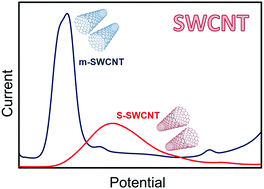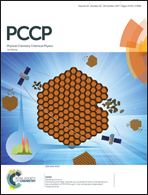Semi-conducting single-walled carbon nanotubes are detrimental when compared to metallic single-walled carbon nanotubes for electrochemical applications†
Abstract
As-synthetized single walled carbon nanotubes (SWCNTs) contain both metallic and semiconducting nanotubes. For the electronics, it is desirable to separate semiconducting SWCNTs (s-SWCNTs) from the metallic ones as s-SWCNTs provide desirable electronic properties. Here we test whether ultrapure semi-conducting single-walled carbon nanotubes (s-SWCNTs) provide advantageous electrochemical properties over the as prepared SWCNTs which contain a mixture of semiconducting and metallic CNTs. We test them as a transducer platform which enhanced the detection of target analytes (ascorbic acid, dopamine, uric acid) when compared to a bare glassy carbon (GC) electrode. Despite that, the two materials exhibit significantly different electrochemical properties and performances. A mixture of m-SWCNTs and s-SWCNTs demonstrated superior performance over ultrapure s-SWCNTs with greater peak currents and pronounced shift in peak potentials to lower values in cyclic and differential pulse voltammetry for the detection of target analytes. The mixture of m- and s-SWCNTs displayed about a 4 times improved heterogeneous electron transfer rate as compared to bare GC and a 2 times greater heterogeneous electron transfer rate than s-SWCNTs, demonstrating that ultrapure SWCNTs do not provide any major enhancement over the as prepared SWCNTs.



 Please wait while we load your content...
Please wait while we load your content...